|
I could never see myself as a combat pilot. Then again, I've never been pressured to participate in armed conflict, at least one staged on an international scale. Knives waved in threat in the heat of misspent youth don't really count here, neither does getting hit with a police baton at an anti-nuclear protest. The pacifistic direction my politics took once I put my directionless teenage years behind me made it seem unlikely I would willingly take part in a war even if ordered to do so. And such a situation did nearly once arise. When the Falklands conflict exploded I was still at serviceable age, and a family friend who worked in government told us that plans were being drawn up for conscription if the conflict dragged on for long enough. Given the weight of protest against the war at the time, I think the authorities would have had a fight of a different sort on their hands had they tried to enforce it.
But given that we are exposed to stories of men and women under fire on an almost daily basis, and that they continue to be the source of fascination for filmmakers and the viewing public alike, it's perhaps inevitable that even the most peaceful minded of us will at some point try to envisage how we would cope in such a situation. We can't, of course, largely because it's so far beyond the extremes of our experience and we simply have no reference points on which to draw. But we imagine nonetheless, and personally I always seem to see myself dug down in a trench with the infantry boys, a common foot soldier with a keen instinct for survival and a healthy disrespect of those in command. The idea that I might have served aboard a battleship or an aircraft carrier simply never occurred to me, but I always knew for sure that I would never have been a pilot. I get nervous going above the second floor of even the stoutest building, saw no good reason to get on a plane until I was in my thirties, and still quake with terror every time one takes off or lands or is buffeted by turbulence. Just the thought of swooping and soaring in the cockpit of a plane to avoid enemy fire or diving towards a target to unleash who knows what turns my stomach inside out. Hence my opening statement.
But as is so often the way, I'm still captivated by stories of those who do and did fly planes into hostile territory. I used to work with a man who served as a gunner on Lancaster bombers in WW2 and I would drive him half potty with requests for more stories, adventures that he deemed unremarkable but that always struck me as extraordinary. I remember him once telling me of a landing that took place after a particularly bad skirmish, at the conclusion of which he and his comrades had made a hasty exit through the side of the plane as soon as it landed. "Was there an emergency escape hatch there?" I asked, trying desperately to recall the layout of this extraordinary aircraft. "No," he replied with just a whiff of surprise, "there was a bloody great hole where we'd been hit by enemy fire."

Not sharing my fear of flying in the slightest is young Jack Powell (played by Charles 'Buddy' Rogers), one of the two young male leads of William 'Wild Bill' Wellman's 1927 WW1 drama Wings. Jack, you see, has dreamt of being a pilot since he was knee high to a sparrow, and with the outbreak of war has only one thing on his mind, to join up and serve in the US Air Force. Jack is the sort of male lead who was almost unique to silent cinema, one whose unbridled enthusiasm for whatever it is that preoccupies his thoughts makes him blind to the attentions of the lovely girl next door, who in the case of Mary Preston also appears to be a great deal of fun. And Mary is played by the delectable Clara Bow, who had skyrocketed to superstar status as the epitome of female sex appeal in the 1927 film It, which led to her being known widely as "The 'It' Girl". Clearly someone forgot to point this out to our Jack, who only has eyes for city girl Sylvia Lewis (Jobyna Ralston), who unbeknown to him is in love with young moneybags David Armstrong (Richard Arlen), who is actually a lot nicer than that rather glib description must make him sound. Indeed, he's such a nice guy that he makes no attempt to correct Jack's cocksure conviction that Sylvia is really in love with him. So blind does this make Jack to Mary's affections that he almost forgets to bid her goodbye before heading off to war. When he does pay her a quick visit she gives him her picture to carry with him for luck, but still the penny fails to drop and instead of giving her the expected goodbye hug and kiss, he warmly shakes her hand and tells her she can borrow his car while he's away, as long as she doesn't crash it. What a guy.
All of this takes place in the briskly paced opening twenty minutes, but there's more going on here than a light-hearted drama of misplaced emotions. While Jack hops off to war with the enthusiasm of a child on his first trip to Disneyland, David's departure is a more soberly staged affair, with his imminent farewell mourned by his mother and father and even his dog. The parents' fear of losing their only son is heartbreakingly communicated by a pair of finely judged performances by Henry B. Walthall and Julia Swayne Gordon as David's father and mother – there are no histrionics here, just painfully convincing looks of constrained despair. If you hadn't already realised that Wings is something special, then this quietly affecting scene should leave you in no doubt. That Jack and David sign up together and end up in the same unit should come as no surprise, nor should the fact that Jack takes an instant dislike to the man he believes is his rival for Sylvia's affections. This climaxes in a boxing match where David's stubborn refusal to quit after being repeatedly knocked to the ground so impresses Jack that the two instantly become the best of friends. Oh, if only life were like that.
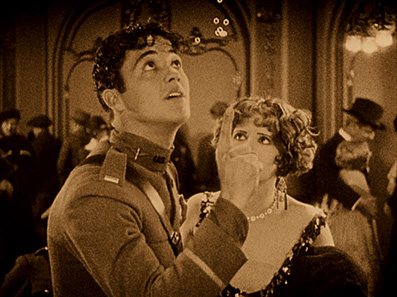
Given the film's age, the expectation is that it will play out like a template for the majority of military service films that followed, an archetype whose once fresh content has been recycled since to the point where it teeters on cliché. Yet while some elements certainly went on to become motifs of the airborne wartime drama, they often play out differently to how you might predict. The fliers' furlough in Paris is a case in point. That the boys get drunk, cause a ruckus and end up consorting with the local ladies is very much how such things played out from here on in, but the on-screen presentation of Jack's hallucinatory conviction that there are champagne bubbles emerging from everything from cabinets to bedposts most definitely is not. Complicating matters further is that Mary has joined the American Expeditionary Forces and arrives at the Folies Bergère just in time to see Jack making a pissed-up fool of himself with a local girl, and his drunken inability to see anything but her uniform only adds to her already weighty sense of rejection. That she ends up sacrificing her service career to protect his virtue without him ever even realising she was right by his side just confirmed to me that the cheery but somewhat self-centred Jack really didn't deserve a girl as devoted and good-hearted as Mary.
As is so often the case with great late silent era works, technically the film intermittently knocks you out of your seat. An early shot in which the camera seems bolted to a moving swing on which Sylvia and David are sitting is so flawlessly executed that I presumed I was looking at a process shot, right up to the moment where Jack walks up behind them and hauls Sylvia off for a ride in his car. For technical pizzazz this is later topped by an attention-grabbing dolly shot in which the camera glides impossibly between seated couples at the Folies Bergère and comes to rest on the wildly partying Jack.
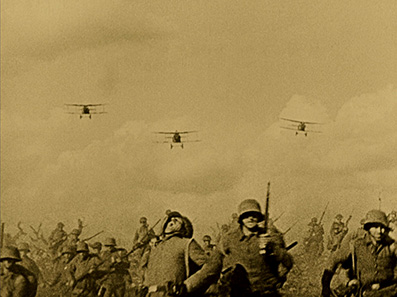
The battlefield scenes are breathtaking in scale and handled with a sometimes documentary realism. The dogfights are consistently superb, a thrilling blend of floating aerial wides, locked-on-pilot mid shots and astonishing rear cockpit views of Jack's plane swoops down at scattering troop lines or shoots up and ignites an observation balloon. A German bombing run on a small village in which American troops are stationed appears to have been staged for real (we get a bombardier's view of the shells falling to earth and blowing the houses to smithereens), and a single visible cable used to haul a church steeple to earth in no way diminishes the epic nature of the ground level destruction.
One technical aspect whose first appearance really will catch you by surprise if you go in unprepared is the use of what was known as the Handschiegl colour process, where portions of a picture – specifically machine gun flashes, explosions and the flames on damaged aircraft – were colour painted by hand and printed onto the film, which has the effect of making flames look animated, which in a sense they were. I actually found this a little distracting, a reminder in the midst of otherwise realistic battles that I was watching a staged construct, but although recreated digitally here, it is authentic to how the film originally screened and it must have seemed quite something back in pre-colour days.
There are also plenty of other sequences to cherish: the moment where Mary is surprised by MPs looking for Jack that startles for its split second glimpse of a topless Clara Bow; the physical tests that the trainee airmen undertake that have a whiff of those used to prepare astronauts in The Right Stuff; the exhausted infantryman who stops to rest and is discovered to have died because he was unable to flee a German attack run; the battlefield double-exposure whose scale and compositional beauty would not be out of place in Sergey Bondarchuk's War and Peace; the documentary footage of the post-war Champs-Élysées; the sequence in which a German staff car is destroyed by Jack's plane, one whose spectacular execution would not be out of place in a more modern work. Seasoned airman White, whom Jack and David briefly meet and bond with, is played by an effortlessly charismatic young Gary Cooper, and there's a shot of the squadron sergeant (played by the brilliantly named Gunboat Smith) leaning angrily down towards the camera that pre-empts a strikingly similar one in Stanley Kubrick's Full Metal Jacket. You think I'm exaggerating? Check out the stills below.
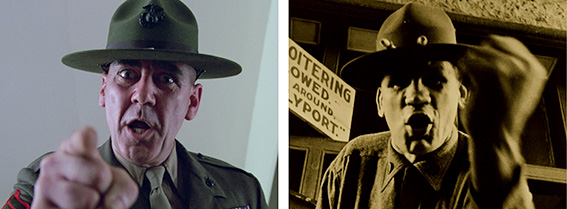
I fully expected to be entertained by Wings, but anticipated having to make a few allowances for the storytelling and acting and even the effects, but was actually required to do no such thing. The narrative may have its share of genre tropes in the making, but they're handled with a breezy efficiency and offbeat detail that makes them feel fresher than you would expect. The passing of time and a familiarity with key elements (a refusal to fly without a lucky mascot does tend to plant a cloud over a character's fate) does bring a degree of inevitability to some of the plot strands, but the journey there rarely plays out as expected, peaking in a final air battle whose tragedy and bitter irony casts a serious pall over an ending that was clearly designed to be read as upbeat.
That the performances sometimes display a degree of expressive exaggeration is par for the late silent era course, but all are entertaining and there is a surprisingly level of subtlety evident elsewhere. It's also worth noting that an emotionally charged climactic scene between Jack and David – which includes the first instance of a man kissing another on screen as an expression of brotherly love – actually reduced this normally cynical fool to tears.
In spite of its age, Wings is a prime example of the early Hollywood big-budget cinema at its most ambitious and entertaining and a standard-bearer for the specific pleasures of the air combat drama. It remains one of this sub-genre's most satisfying achievements, being endlessly borrowed from but rarely if ever bettered – only Howard Hughes' epic 1930 Hell's Angels gives it a serious run for its money, and even that owes a sizeable debt to Wellman's movie. It feels somehow apt that Wings was the very first film to win a Best Picture Oscar (a category that was then called Outstanding Picture) at the inaugural Academy Awards ceremony in 1929. And given my fear of flying, I'll happily doff my cap to the bravery of the film's seemingly fearless stunt pilots and its two leading men, whose in-cockpit shots were all done for real, a feat that required them to take flying lessons, then simultaneously play their roles whilst piloting their planes with other aircraft on their tails and operate the on-board camera. Now that's dedication to your craft.
Meticulously restored by Paramount from damaged original materials, the image quality here both shows and in other ways belies its age. The image is certainly not as crisp nor the contrast as generous as you'll find on the gold standard restorations of films from this period (check out the MoC Blu-rays of Fritz Lang's M or F.W. Murnau's City Girl), and in this respect looks every inch a film of its day. But a quick watch of the accompanying featurettes gives a clear indication of the difficulties faced by the restoration team and you really start to appreciate the remarkable job they've done. City Girl it may not be, but the picture is stable, there is still often a very good level of detail, and scratches, flicker and damage have been reduced to an almost imperceptible minimum. The original colour tinting has been carefully recreated and as ever does take the edge off the sharpness – more surprising, perhaps, is that the night scenes have been graded to actually look like night rather than simply given the usual lavender hue. All things considered, an excellent job.
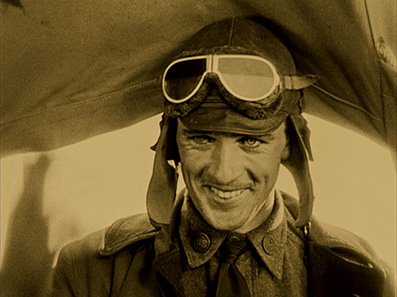
There are two soundtracks on offer – a Wurlitzer organ accompaniment by Gaylord Carter and the full orchestral score by J.S. Zamecnik that accompanied the early screenings, at least those held in cinemas large enough to house an orchestra. While the Carter music has a definite silent cinema charm, the Zamecnik orchestral score is unquestionably the star here, adding urgency to battles, upping the emotional impact of the personal dramas and even weaving in a number of traditional and contemporary tunes (La Marseillaise for the medal ceremony, I'm Forever Blowing Bubbles for Jack's drunken hallucinations). But there's more. Also incorporated are a good many sound effects, including gunfire, aeroplane engines, explosions and even punches, sounds that were apparently also played as part of the original cinema screenings. At first I found this a little odd, but soon grew to like it and now find it hard to imagine the film playing without this element. While the Carter score is the expected (and crystal clear) Linear PCM stereo, the Zamecnik score is pristine DTS-HD Hi Res 5.1 surround. The music sits at the front, but the effects make full and clear use of the entire sound stage, and include some excellent LFE bass for the engines of the German Gotha aircraft and the beefier explosions.
Wings: Grandeur in the Sky (35:58)
A hugely engaging look back at the making of the film, one that follows its production from original conception through to its release and eventual Oscar win. Particularly interesting are the stories about director William Wellman (whose son is one of the contributors here), his ambition, attention to realism and conflict with studio execs. Other areas covered include the casting of Gary Cooper (whose career this film launched, despite the fact that he is only on screen for a couple of minutes), the $15 million worth of men and equipment provided by the army, the logistics of filming the final battle, the work of cameraman Harry Perry and is sizeable team, the technical process of filming the actors in flight, the work of the stunt crew and a whole lot more. There's even a round-up of the cameo roles in the film over the closing credits. An excellent companion to the film.
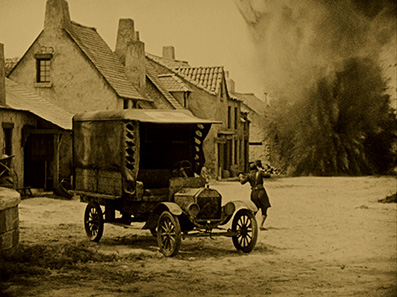
Restoring the Power and Beauty of Wings (14:23)
Some of those involved in the restoration take us through the process of restoring the film to its present fine condition in a clear and enthralling manner. All aspects are covered, from the digital repair of the picture through to the recording of the score and the sound effects. Especially pleasing is the news that the colour tinting and the Handschiegl colour work was all scripted in some detail when the film was first made, providing precise instructions (and we're talking specific frame numbers here) for the restoration team to follow.
Dogfight! (12:56)
Pilots from the Old Rhinebeck Aerodrome, who specialise in staging dogfights in WW1-era planes, relate the evolution of early aerial warfare in engaging and revealing fashion. I was especially intrigued to hear that the first aerial battles were not fought with guns but with bricks and grappling hooks.
Booklet
An excellent read, as ever, the accompanying booklet features an intriguing and well illustrated essay on Wellman by Gina Telaroli, a revealing 1978 interview with the director by Scott Eyman (which includes specific questions on Wings), a sizeable and entertaining excerpt from Wellman's autobiography, A Short Time for Insanity, that focuses on the making of the film, plus credits, archival stills and the usual notes on correct viewing.
A thoroughly entertaining tale of wartime love and friendship that entrances on the ground but really soars once in the air through some of the most thrillingly filmed air combat the screen has ever seen. Gripping, intermittently exciting and emotionally involving, Wings is described in one of the extra features as the last of the great Hollywood silents, and over 85 years on it still has the power to enthral and surprise. Paramount has done a spanking job on the restoration and has also provided three terrific extra features, which are further complimented by Eureka's typically excellent booklet. Another stonking release from the Masters of Cinema label. Highly recommended.
|